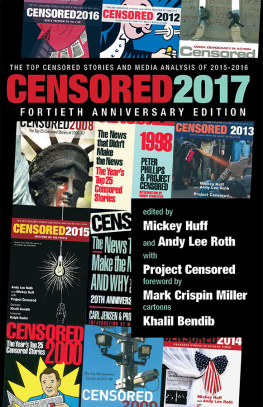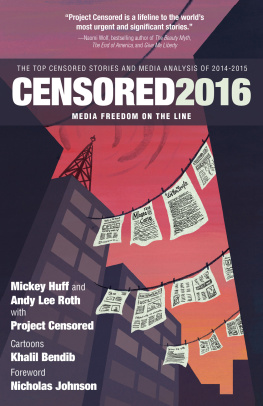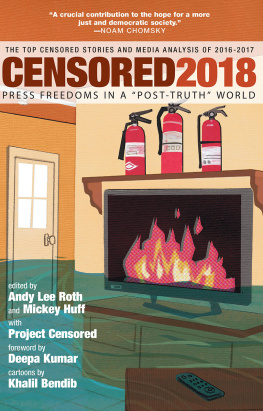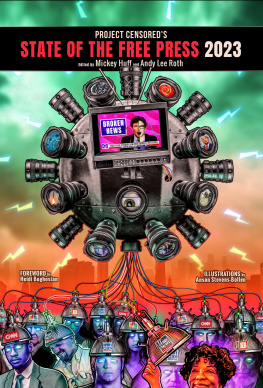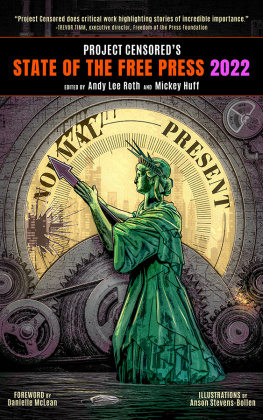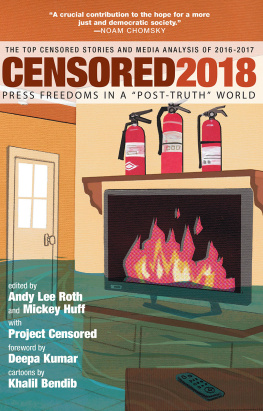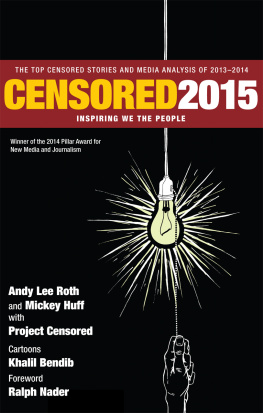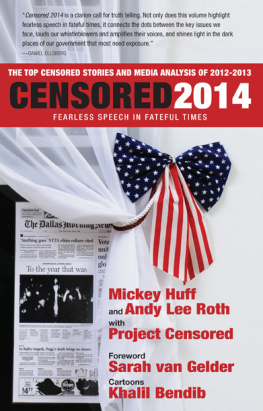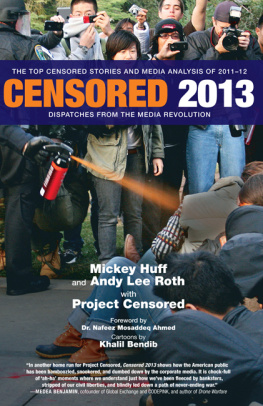All rights reserved. No part of this book may be reproduced, stored
in a retrieval system, or transmitted in any form, by any means,
including mechanical, electronic, photocopying, recording or other
wise, without the prior written permission of the publisher.
PUBLISHERS NOTE
That Project Censored has survived and thrived for forty years is a testament to this incredible team of people and also to the enduring power of the idea that monitoring news censorship can keep our democracy going. Real democracy in America is constantly under assault, but the simple fact that Project Censored exists means that the kind of investigative reporting the Project celebrates, and the publications that support investigative reporting, have a forum and even a reward for their efforts and talent and sacrifice.
I remember meeting intrepid reporters like Gary Webb and Sidney Wolfe and so many others through Project Censored, including young journalists who were being celebrated for a story theyd written and it may have been the first time a story theyd written had a life beyond initial publication. And it felt great, like we were on the winning team.
So much of this kind of research and nonfiction writing happens in isolation, even extending to and including publication. I remember that, often, it was at the Project Censored Awards that writer and publisher met in person for the first time.
For four decades Project Censored has also initiated thousands of college students into the world of censorship and investigative reporting, not only at Sonoma State University where the Project was founded in 1976, but also at dozens of colleges and universities around the country.
Under successive directors, founder Carl Jensen, then Peter Phillips, and now Mickey Huff with Andy Lee Roth, the Project has continued its work as one of Americas strongest alternative media institutions.
As Project Censoreds publisher through all but one of the years that they have produced an annual volume of censored stories, Censored, Ive been amazed at the resilience and joyfulness this organization has shown, year after year. Forever young, and ever more important, Project Censored makes us all better-informed and more empowered as citizens.
Dan Simon, Publisher, Seven Stories Press
Contents
FOREWORD
Our Free Press as a Clear
and Present Danger
Why We Need Project Censored Forty Years Later
Mark Crispin Miller
I
Concerning what we call the media today, it is the best of times, it is the worst of times. First, the worst....
Ive been studying the US press since it elected Ronald Reagan back in 1980. Since then, our free press has often failed completely to keep We the People properly informed, instead colluding, avidly, in one state propaganda drive after another (with some of us trying, vainly, to oppose it).
Let me be clear: throughout those years, as even now, there was much excellent work produced by serious reporters. But when the chips were down, the state about to strike, and people needing most to hear some truth, there wasnt any to be heardat least not enough to make a difference.
Thus our free press unanimously justified the 1983 invasion of Grenada, the 1989 invasion of Panama, the first US Gulf War in 1990 (unanimously hailing it as a miraculous success), and the intervention in Yugoslavia in 1999 (unanimously blacking out the horrors of NATOs humanitarian bombing there).
Such unity against The Enemy dates back to World War I, when our free press was first systematically deployed for propaganda purposes. To treat us not as citizens to be informed, but as subjects to be mobilized for war, was the purpose of most news about the Hun in World War I, the Soviets from 1917, the first Red Scare in 1919, and,eventually, the long Cold War, pitting us against the Red Colossus that would crush our freedom, rights and propertyand our free press.
There is, of course, some irony in that last threat because our free press itself was often just as bellicose, authoritarian, repetitive and hostile to dissent as its chained counterparts behind the Iron Curtain. Far from hailing those who tell the awful truth, as in All the Presidents Men, the US press has often banished them. In 1939, George Seldes, veteran foreign correspondent, was savaged by newspapers nationwide for blasting their fantastic claims about the Soviet invasion of Finland, in a four-part series that no major magazine would touch, so it ended up in the New Masses (where it was mostly read by Communists). Although his study was confirmed by the Institute for Propaganda Analysis at Columbia University, Seldes realized that he would never find a proper readership unless he went outside the daily press, and so he started up In Fact, his independent newsletter, which ran from 1940 to 1950.
1. F. Stone had a similar experience in 1952, on the publication of The Hidden History of the Korean War a meticulous dissection of precisely how and why the US had allowed that war to start, and then kept it going. Because his book went far beyond the usual story of the wars beginning (North Korean aggression), and noted the atrocities by US forces (as in Operation Killer), it was turned down by over two dozen publishers; and when it finally did come out on Monthly Review Press, our free press largely greeted it with silence until a hit piece by liberal journalist Richard Rovere in the New York Post, which pushed Stone out into the wilderness for years, forcing him to follow Seldess lead with I. F. Stones Weekly, which ran from 1953 to 1971.
Nor was it only wayward journalists who got that treatment. Some long-cherished illusions of mine about the great free press in our country underwent a painful reappraisal during this period, wrote Jim Garrison, noting how, in 1967, the media went after him en masse for seeking to crack open the conspiracy to murder President John F. Kennedy: As far as I could tell, the reports and editorials in

